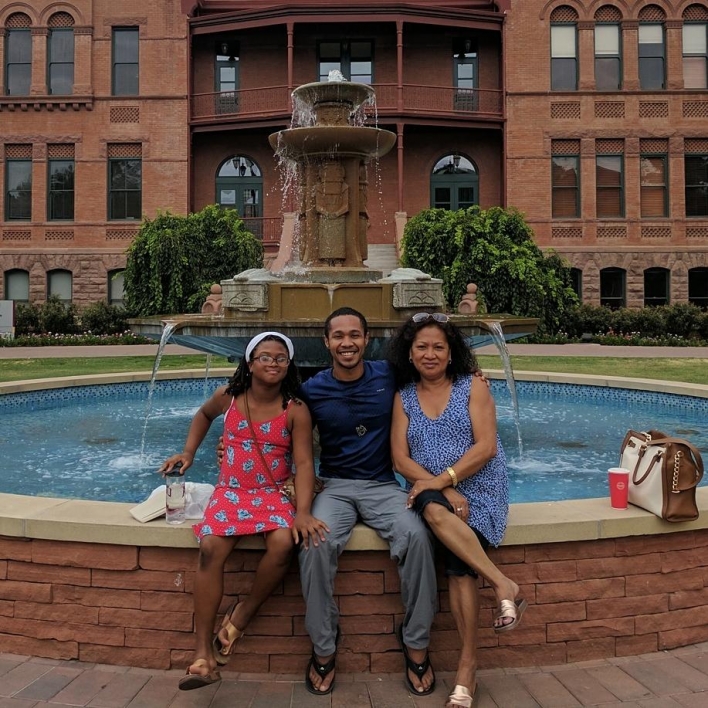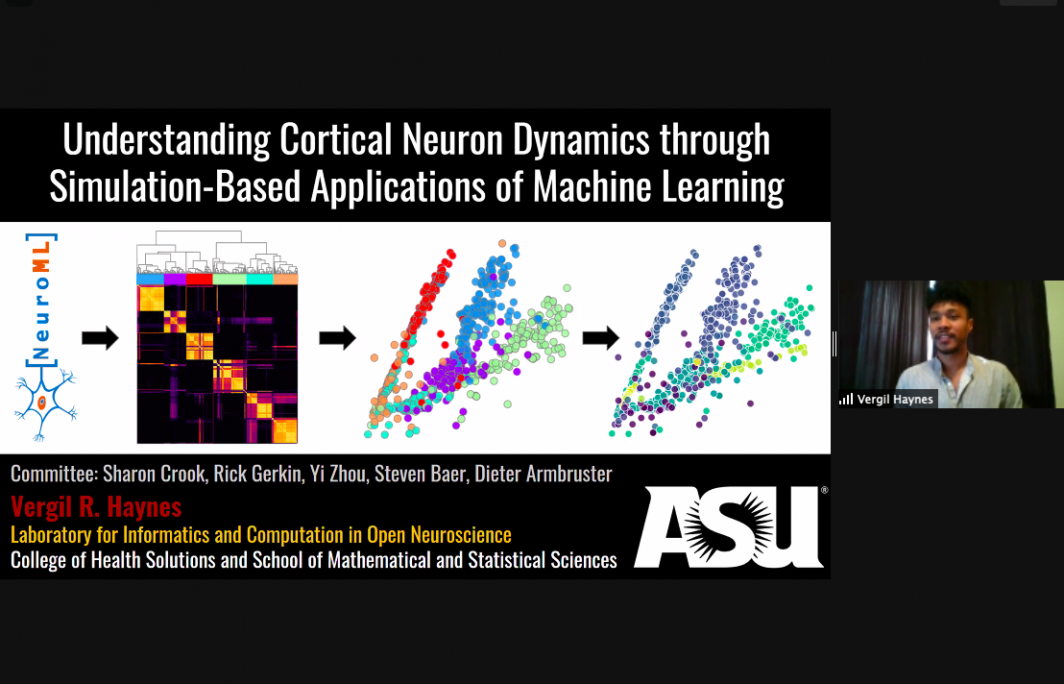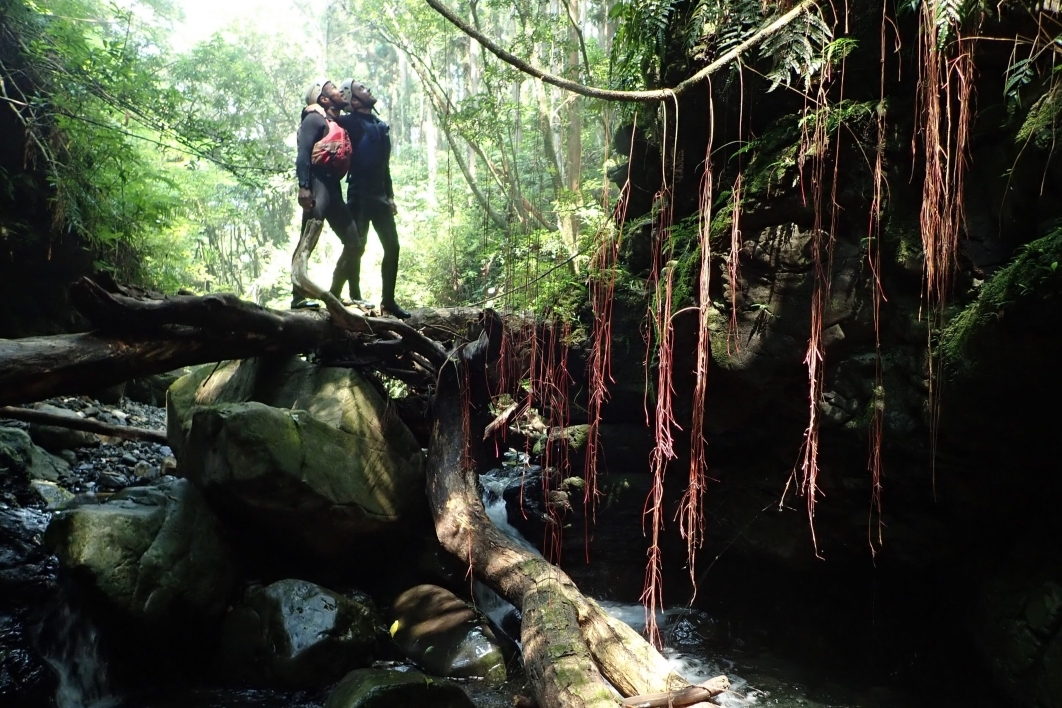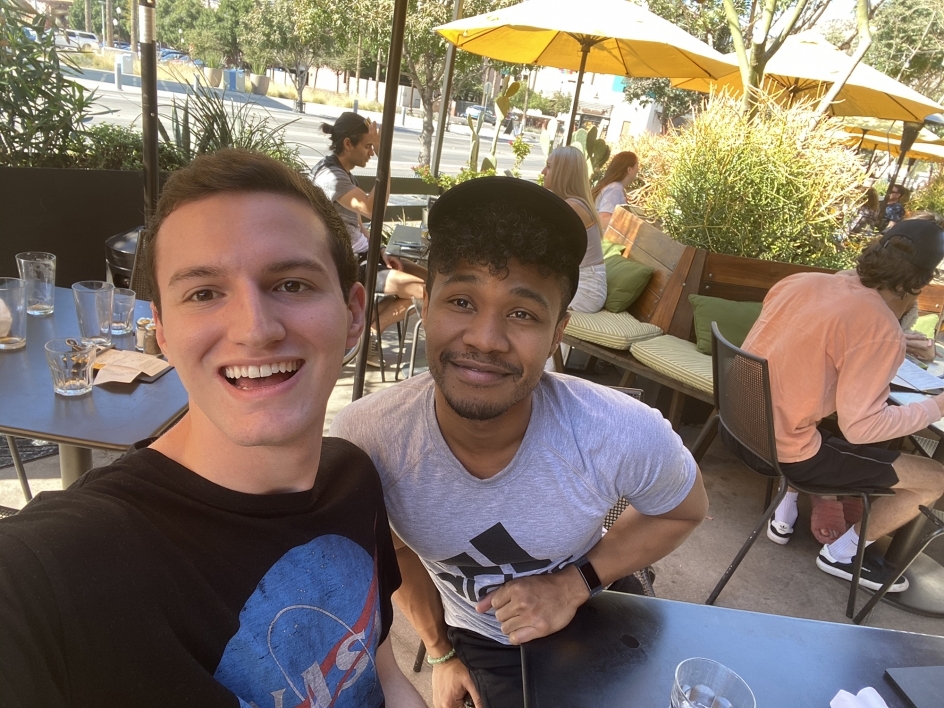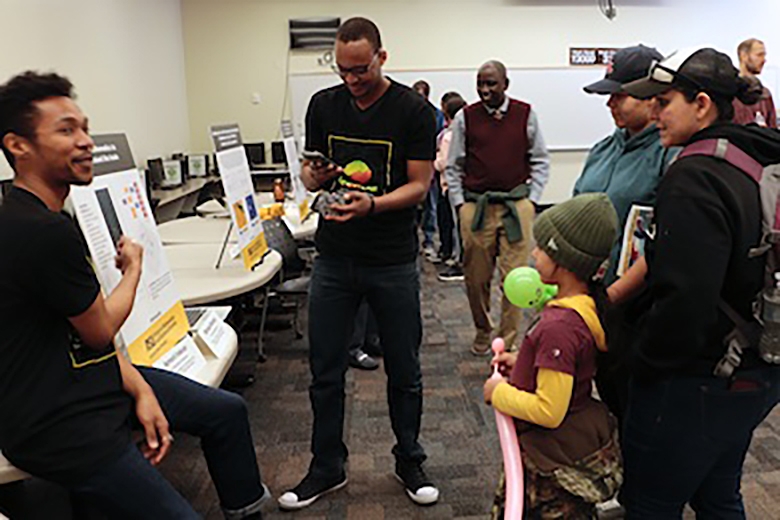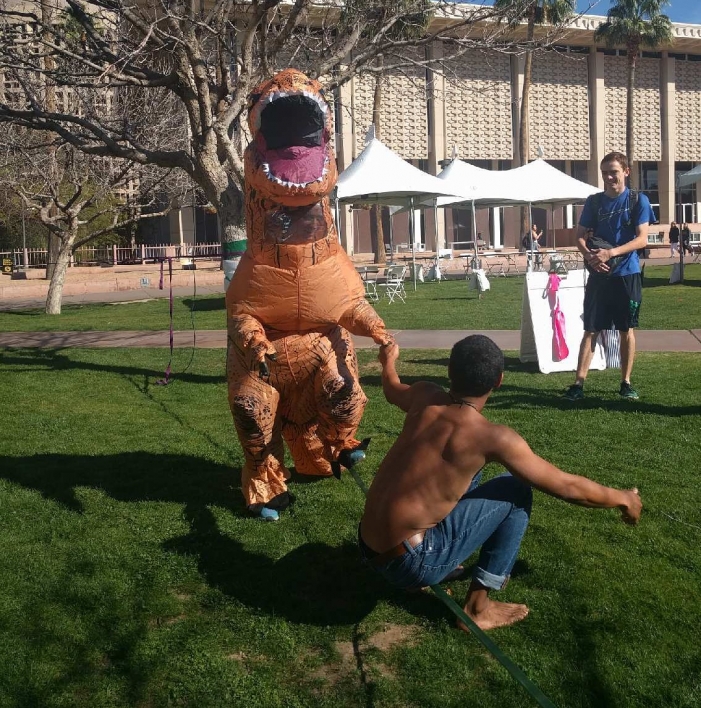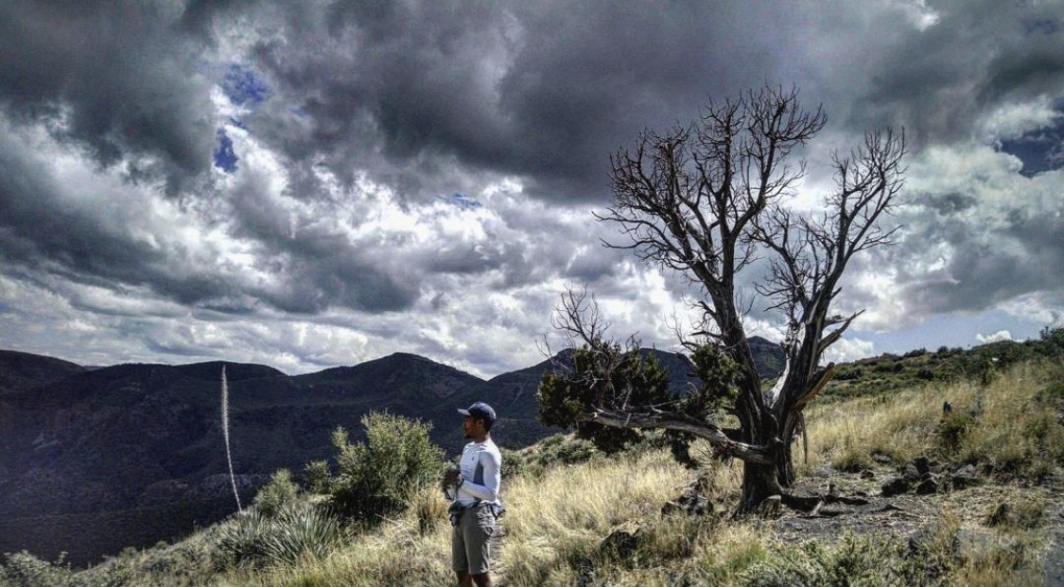PhD grad uses math to explore the brain

Vergil Haynes wears a surface electroencephalogram (EEG) recording cap. Surface electroencephalography is a method for recording electrical activity associated with brain physiology from the scalp.
Editor's note: This story is part of a series of profiles of notable fall 2020 graduates.
Vergil Haynes is graduating this month with a PhD in applied mathematics from Arizona State University. His research approaches old neuroscience questions but in new ways. Although the questions are simple in appearance, long-held assumptions about them have limited new insights for decades.
“Often times when you are recording activity in the brain, you don’t know precisely what influences the signals you record and this limits your ability to interpret those signals,” Haynes said. “Do they come from one type of brain cell or another? I ask, what is the origin of certain brain signals associated with individual brain cells, and whether knowledge of those origins can aid in improving data analysis techniques.”
“Another problem I’m concerned about is community standards for modeling. Many assumptions are built into very detailed simulations of brain cells. For example, cells have protein structures in their membranes. I developed a framework for figuring out whether there are common patterns for these structure in how many there are, where they are, and what they do. For both of these problems, I use a combination of simulations, machine learning, and advanced statistical techniques to also challenge assumptions about how brain cells are grouped based on recorded signals.”
“Vergil is detail oriented in his research and has an astonishing knowledge of the literature. This helps him see the big picture and understand where his work lies with respect to previous and ongoing research in the community,” said Sharon Crook, Haynes’ adviser and professor in the School of Mathematical and Statistical Sciences.
“Vergil will stay in our group as a postdoctoral researcher for a year in order to help us advance the research that he has been contributing to. Uniquely, he has the perfect combination of skills for this work which requires both the development and execution of computational models and also machine learning to analyze large datasets,” said Crook, lead researcher of the Informatics and Computation in Open Neuroscience (ICON) Lab.
The lab contributes to large, collaborative enterprises such as the NeuroML Initiative, OpenSource Brain, and the Human Brain Project, which lead to building an interconnected infrastructure for the advancement of computing within neuroscience based on transparency and accessibility.
Vergil Haynes (third from left) with Sharon Crook (center) and other members of the ICON Lab at ASU. Photo courtesy of ICON Lab
Haynes will also continue as a post doc in the Auditory Computation and Neurophysiology Lab in the College of Health Solutions, which investigates the neural mechanisms of perceptual and cognitive functions that support auditory experience.
“I’m excited to work with the same two labs – one is very experimental oriented, and the other is very modeling oriented, and I’m at the intersection of these two,” he said.
Haynes was born and raised in Melbourne, Florida, about 30 minutes south of NASA’s Kennedy Space Center at Cape Canaveral. As a kid, he watched the rocket and shuttle launches from the beach. “You could actually feel the sonic boom, it would shake windows and everything,” he said. Many of his friends back home still think of him as someone who would one day be an astronaut, since that is what he was always saying.
“I think it is still a possibility,” Haynes said.
Haynes is closest to his one maternal sibling, a brother about 10 years older, born to a different father who was in the Air Force. His mother is from the Philippines and moved to the U.S. a few years after his brother was born. It was here in the states that she met Haynes’ father.
Haynes is a first-generation college student, raised primarily by his mother. His father was mostly out of the picture.
“I could probably count on two hands how many times I’ve seen him in my life,” he said. His mother had a boyfriend for most of his childhood, but they did not get along.
His brother went to juvenile detention at a young age, and was later incarcerated for marijuana-related offenses that nowadays might not involve jail time.
“Due to the lack of social mechanisms to reduce high prison recidivism rates in the U.S., and like many community re-entries, my brother was reincarcerated multiple times over his early adulthood,” Haynes said. Even after participating in a recent work-to-release program, Haynes' brother still struggles to figure out how to get his life going.
“It was like every direction I looked for a male role model, I just couldn’t find one,” Haynes said.
Vergil Haynes, a first generation college student, with his mother and niece on the ASU Tempe campus. Photo courtesy of Vergil Haynes.
His mother worked as a restorative technician at a rehabilitation nursing home back in Melbourne. She mostly worked with dementia patients, helping them to be able to feed themselves or walk again.
“My mom would work double time, overtime, lots of holiday hours, so usually it was just easier if I just stayed there all day. I mostly lived there as a kid. I’d sing to the elderly, take them to lunch, play chess or Uno with them,” Haynes said.
“My mother often won awards for being compassionate, generous and kind to co-workers and residents at the nursing home. This instilled in me that supporting people was one of greatest gifts you could give someone – and sometimes this took hard work and sacrifice.
“Those experiences were very formative in a lot of different ways in my life. Especially in trying to understand people. How do they think? Why do they wind up thinking a certain thing, or not be able to think at all, or remember at all?”
In school, Haynes’ teachers would tell him he was unmotivated, didn’t have goals – but also had a lot of potential. He would sometimes fall asleep in class. He often got in trouble, resulting in suspensions or Saturday school. He failed quite a few classes in high school and almost didn’t graduate. His counselor and principal agreed on a plan so he could take adult education classes after school and still be able to graduate.
“I was like, ‘Oh, I made all these choices and now I’m seeing the consequences of them,’ which is that I might not get this diploma,” Haynes said. “And then I’ll live this life like the rest of my family has been living, not even having finished high school.”
There was a lot of hopelessness around that period of time. But there was also the peer pressure of seeing a lot of his friends were set to graduate, so he wanted to. One of the most motivating things for him was how much time he was spending with other people’s families.
“My mom had moved out of the projects and into this fairly nice suburban area, and I had met some friends and started hanging out at their houses. It was like, ‘Oh wow,’ your dad works at NASA, your mom is a financial adviser, and you have this nice house. For the most part, there might be some yelling here or there, but it’s not constantly hostile here. I remember them giving me a lot of validation, as well.
He spent considerable time with academic advisers figuring out how he could pay for college. He got a Medallion Scholarship which paid for 75% of his tuition for a four-year degree. To cover the rest, he took out loans and worked a couple of jobs throughout his undergraduate years.
“I told my mom I was going to get a PhD and she was like, ‘How are you going to do that? We don’t have the money for that,” said Haynes. “All her co-workers said, ‘Let him dream and let him do his thing, and he’ll figure it out as he goes.’”
At the same time, Haynes found himself repeating old patterns, using avoidance behaviors. If a class interested him, he would do well. But if a class stressed him out, he would stop going. He was convinced the system was trying to keep him down. There were many setbacks, and he ended up failing a math class.
“I remember that was also the time in my life where my dad and I had tried to start talking with one another again, and I think I was still hesitant. I was finding out more about who is this person, and I wasn’t really liking what I was seeing, but I was trying to reach out and say this is something that I want to try to rebuild.”
Asking his dad for help led to a huge family blowup. “It got to the point where it was like, OK, that was my last attempt.”
That situation drove him forward, in a sense, since there was less constraining him to be near family. He was ready to go forward on his own. After getting his two-year associate degree, he transferred to the University of Central Florida, one of the largest public universities in the country. He was excited about all the different kinds of classes he could take. By the end of his first year at UCF, he changed his major from pre-med/biology to mathematics.
He was taking Calculus III, Linear Algebra, Introduction to C Programming — those were the classes that convinced him to keep going. He took a logic and proof class that he thought was really fun.
“Just the process of doing homework with people, doing projects with people and how intellectually stimulating that was, and also this sense of how I contributed some sort of value to this discussion. That was when I really started defining my personal value in relationship to math,” Haynes said. “People started coming to me asking for help or wanting for me to explain certain things. I was like, okay, actually I’m good at this.”
He had a network of people who were supporting him, but also had some people who were trying to get in his way. Particularly the faculty undergraduate adviser in the mathematics department, who he met with a couple of times. Haynes wanted to major in math with a concentration in physics. The advisor briefly looked over his academic record, which was not stellar, and then dissuaded him from pursuing that route. “Maybe this isn’t something for you,” he said to Haynes.
“I remember that resonated with me for a long time.”
Haynes knew he had an interest in research, so he reached out to a professor who studied mathematics and biology, and would later become his faculty adviser.
“It was a lot of leaning into him, weekly sessions with him. He would teach me how to read math papers and how to do research. He also instilled in me a sense of beauty.
“I still remember the time I came to him with my first result. It was really simple. And it was something he had been missing for a while. I showed it to him and he had this moment where he stepped back, leaned against the table and was like, ‘Wow, that’s beautiful.’ And I was like, whoa, I had never shared that kind of moment with someone before. And I was kind of hooked.”
When Haynes applied to graduate schools, he hoped he might be offered a Teaching Assistantship. He received his only offer from Arizona State University and got a phone call from the Hispanic Research Center stating he had won the NSF Louis Stokes Alliances for Minority Participation (Bridge to Doctorate) Fellowship.
Once he got to ASU, he knew he wanted to transition into something more related to neuroscience. During his first year of grad school, he took a mathematical cell physiology class with professor Sharon Crook. The following year he reached out to her.
“As far as the math department goes, Sharon has always been deeply supportive. I can tell her all of these personal things that I would normally not tell any sort of authority figure or someone that could sway my professional life,” Haynes said.
Haynes identifies as being poor, being Black, being biracial (half Filipino) which is a unique kind of being Black, and also being a queer male.
“Being part of the LGBTQ community, I’ve met a lot of peers and colleagues who are also part of that community, at different stages with coming out, or being out at work," Haynes said. "There are many mental-health issues that can be exacerbated while feeling closeted and isolated, and navigating that is something I’ve become familiar with.”
“I definitely found my peer group here at ASU. They are scattered across a lot of different departments. But as far as my identifiers go, most people I’ve become close to have been very open to discussing how growing up at the intersection of all these things has really shaped me, and also provided a lot of opportunities for me to create my own barriers. But the people that I’ve met here at ASU have done a lot to help me dispel some of those barriers.
“ASU is this unique ecosystem where I’m allowed to branch out in unique ways that I never would have been able to at other universities.
“Being at ASU and around all these things, like Changemaker Central, for example, where you’re trying to solve community problems through these different lenses – they really do reinforce this idea that being at the intersection of things is very valuable.
“In general, I’ve come out of ASU very optimistic about what it is that I can accomplish, and how I can connect to other people to help them with the things that they want to accomplish, or what we can accomplish together.
We asked Haynes to share a bit more about his doctoral journey as a Sun Devil.
Question: What was your “aha” moment, when you realized you wanted to study mathematics?
Answer: I’ve never thought math was my strong suit growing up. I was good at it, but it didn’t really interest me until my undergraduate education. I was originally a premed/biology major for the first few years of my degree. I recall being dissatisfied with lab work and the way courses were taught in biology, example after example. I eventually switched into physics as a major and picked up two books that ultimately convinced me to study mathematics for the rest of my degree. The two books were: Leonard Mlodinow’s “Euclid’s Window,” about the evolution of geometry from the Greeks to modern physicists, and Isaac Asimov’s “Foundation,” which had a central influencing figure who was a mathematician and psychologist helping humanity survive through a period of barbarism through “matrices” and human behavior. I remember those were very formative in my scientific maturation as I had never really connected deep math with helping society.
Q: What do you like most about mathematics (and your area of concentration)?
A: As far as mathematics goes, what I like most is that my capacity to build “models” has expanded. While research has very formal models, models in general have become central to how I navigate and make sense of life. It’s become very helpful in many areas outside of math. Before I approach most anything, whether it be a project, learning, connecting with people, making decisions, I go through a model building process. I’m always asking whether a certain model and assumptions is appropriate for whatever it is I want to do. Since my concentration is in computational modeling that leverages data, I find myself thinking how I can build better models to do more with my life.
Q: Which professor taught you the most important lesson while at ASU?
A: Hands down, Dr. Sharon Crook — my PhD adviser. I’ve worked with Sharon for so many years now and I’ve shared both great intellectual moments with her but also moments for humanity, humility and humor. She taught me that scientists can often get hung up in being a scientist, but with the right nudge you can get them to let loose while still enjoying talking about research. I’ve definitely have her in mind when I’ve met new colleagues from different universities. I always make sure to be the one to remind everyone that everyday fun is also integral to science. She’s also helped me stop the excessive need to show off technical knowledge through jargon. She has a very down-to-earth approach because it’s so important that people relate to you and understand you when the subject matter is so rich.
Q: What is the best piece of advice you would give to those still in school?
A: Continuously challenge your assumptions about things. School is a period for growth and figuring out even just a small fraction of life. Keep asking whether beliefs about yourself and others are actually beneficial beliefs. Ask whether your beliefs about what is expected of you, what you invest your time in, and what’s important to you are truly convincing to your best knowledge at the time or do they just feel convincing. In different words, be comfortable with feeling lost and seek it out often. Losing your notions about yourself is part of the process of transformation. I think this is especially important after everything related to the pandemic and the civil unrest we’ve all been feeling. The world is different, and we should be in response.
Vergil Haynes hosted a regular "slack and relax" for ASU students, shown here teaching by far his oldest student how to slackline. Photo courtesy of Vergil Haynes
Q: What was your favorite spot on campus, whether for studying, meeting friends or just thinking about life? (This is more related to before the pandemic.)
A: I’ve always been a fan of the grass yard in front of Old Main. I would set up my slackline, some blankets, play music and enjoy the sun at least once a week. Other students would come up and I found it a fun space to connect with people and talk about life in the midst of all the frantic rushing. It felt good to share moments like those with other students going through similar challenges.
Q: What do you like to do in your spare time for fun?
A: I’m definitely a hobbyist. If I’m feeling more relaxed, I like to read or listen to podcasts. I try to enjoy the Arizona scenery often with walks, hikes, slacklining and trail running. I’ve managed to try out a lot of outdoor activities since moving here like camping, backpacking and snowboarding. I’m passionate about fitness and like to devote time to calisthenics, tai chi, yoga and traditional strength training. I also have several projects that I try to ground my training in coding, data and technology in things related to my health and general performance.
Haynes explores the surrounding Superstition Mountains to de-stress and celebrate passing his comprehensive exams. Photo courtesy of Vergil Haynes
Q: What do you think is most misunderstood about math by the general public?
A: Math is just crunching numbers. It’s not, and some of mathematicians aren’t even good at that. Some really enjoy that, some of us find that really dull.
Q: If someone gave you $40 million to solve one problem on our planet, what would you tackle?
A: I have a lot of family members who have been incarcerated and unable to rebuild a life after reentering society. While I couldn’t solve something like the problem of privatized prisons and the overall corrections market, I think building an organization or cooperative that focused on reentry education, wealth building training, and personal and relational therapy for those leaving the prison system would be something I would put that money in right away.
More Science and technology

ASU to host 2 new 51 Pegasi b Fellows, cementing leadership in exoplanet research
Arizona State University continues its rapid rise in planetary astronomy, welcoming two new 51 Pegasi b Fellows to its exoplanet…

ASU students win big at homeland security design challenge
By Cynthia GerberArizona State University students took home five prizes — including two first-place victories — from this year’s…

Swarm science: Oral bacteria move in waves to spread and survive
Swarming behaviors appear everywhere in nature — from schools of fish darting in synchrony to locusts sweeping across landscapes…



